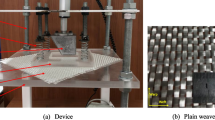Abstract
The results of physical and mathematical simulation and fracture of the cracked surface layer during rolling friction and wedging are presented. The simulation is performed with the Lagrangian method of finite elements using the software package ANSYS with the LS-DYNA problem solver. The regularities of elastoplastic deformation, fracture, and wear rate of the surface layer during contact interaction in rolling friction are analyzed.
Similar content being viewed by others

References
Goryacheva, I.G. and Dobychin, M.N., Kontaktnye zadachi v tribologii (Contact Problems in Tribology), Moscow: Mashinostroenie, 1988.
Kolesnikov, Yu.V. and Morozov, E.M., Mekhanika kontaktnogo razrusheniya (Mechanics of Contact Fracture), Moscow: Nauka, 1989.
Matvienko, Yu.G., Modeli i kriterii mekhaniki razrusheniya (Models and Criteria of Fracture Mechanics), Moscow: Fizmatlit, 2006.
Osnovy tribologii: trenie, iznos, smazka: Uchebnik dlya VTUZov (Tribology Foundations: Friction, Wear, Lubrication: Tutorial Book for High School), Chichinadze, A.V., Ed., Moscow: Mashinostroenie, 2001.
Sosnovskii, L.A. and Makhutov, N.A., Tribofatika: iznosoustalostnye povrezhdeniya v problemakh resursa i bezopasnosti (Tribological Reliability: Fatigue Wear in Safety and Lifetime Problems), Moscow, 2000.
Zafosnik, B., Flakser, J., et al., Modeling of Surface Crack Growth under Lubricated Rolling-Sliding Contact Loading, International Journal of Fracture, 2005, vol. 134, pp. 127–149.
Glodez, S., Potocnik, R., Flakser, J., et al., Numerical Modeling of Crack Path in the Lubricated Rolling-Sliding Contact Problems, Engineering Fracture Mechanics, 2007, vol. 264, pp. 1–12.
Noda, N.A., Yagishita, M., and Kihara, T., Effect of Crack Shape, Inclination Angle, and Friction Coefficient in Crack Surface Contact Problems, International Journal of Fracture, 2000, vol. 105, pp. 367–389.
Bogdanski, S., Lewicki, P., and Schymaniak, M., Experimental and Theoretical Investigation of the Phenomenon of Filling the RCF Crack with Liquid, Engineering Fracture Mechanics, 2005, vol. 258, pp. 1280–1287.
Donzella, G., Faccoli, M., Ghidini, A., et al., The Competitive Role of Wear and RCF in a Rail Steel, Engineering Fracture Mechanics, 2005, vol. 72, pp. 287–308.
LS-DYNA Keyword User’s Manual. Vol. 970: LSTC, 2003.
LS-DYNA Theory Manual. LSTC, 1992.
Author information
Authors and Affiliations
Additional information
Original Russian Text © Yu.G. Matvienko, M.A. Bubnov, 2009, published in Problemy Mashinostroeniya i Mashin, 2009, No. 4, pp. 43–49.
About this article
Cite this article
Matvienko, Y.G., Bubnov, M.A. Contact interaction and fracture of the surface layer during rolling friction and wedging. J. Mach. Manuf. Reliab. 38, 349–353 (2009). https://doi.org/10.3103/S1052618809040086
Received:
Published:
Issue Date:
DOI: https://doi.org/10.3103/S1052618809040086



